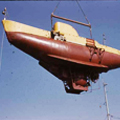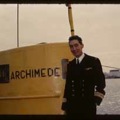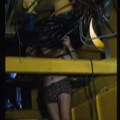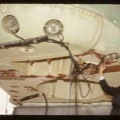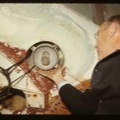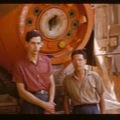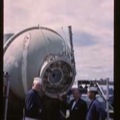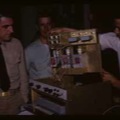Underwater Vehicles
by Claire Calcagno
Doc Edgerton spent much of his time designing instruments specifically to mount on deep submergence underwater vehicles. They ranged from camera and strobe systems that he called “robots” mounted on tow sleds improvised out of boat ladders, to state-of-the-art self-propelled submersibles such as the Alvin. His underwater strobe lights provided illumination for an array of instruments to document and measure the sea depths and its residents, and his sonar tools assisted in locating and tracking these instruments during their deployment.In underwater exploration there are those who favor remote sensing systems to explore remote depths, and those who maintain that a human presence, despite the much greater risks and costs, intrinsically surpasses the value of indirectly monitored sensors. In this discussion, Edgerton was typically eager to help both camps, although from his correspondence it seems he favored remote sensing – what today is known as telepresence. A similar debate has characterized space exploration; it touches on fundamental philosophical questions about technology’s role in acquiring and interpreting knowledge.
Doc’s collaborations with Jacques Cousteau led him to participate in several pioneering efforts at human-presence underwater exploration starting in the mid-1950s. Cousteau’s Soucoupes, or “diving saucers,” ferried pairs of researchers through seas and lakes around the world – with illumination provided by Doc’s ever-evolving strobe lights and sonar positioning devices. Doc also participated in engineering research for the French Navy’s bathyscaphe FNRS III stationed in Toulon, skippered by Lt. Cmd. Georges Houot. Through this connection Doc also assisted in outfitting the Piccard-designed Trieste bathyscaphe, but to his enormous frustration was prevented by unforeseen circumstances from delivering his lights for the famous – and as yet unrivaled — descent of the Trieste to the deepest point in the Earth’s oceans, Challenger Deep in the Marianas Trench, in January 1960. After this Doc was relentless in promoting the importance of photographic documentation of any deep-sea exploration effort, and he did have success with the later incarnation of Trieste II reconfigured for the Office of Naval Research a few years later.
The 1960s was a decade of revolutionary deep-sea exploration – in tandem with developments in space exploration. Other manned vehicles that featured Edgerton-designed strobe lights and sonar pingers include the French deep submergence vehicle Archimede, Cousteau’s underwater human habitat Conshelf III, Edwin Link’s Johnson Sea Link submersible, WHOI’s submersible Alvin, and the first submersible designed specifically for underwater archaeological exploration, the Asherah. And in later years, lights designed by his company’s subsidiary provided illumination for the remotely operated vehicle “Jason Jr.” used to document the newly discovered Titanic shipwreck site.


